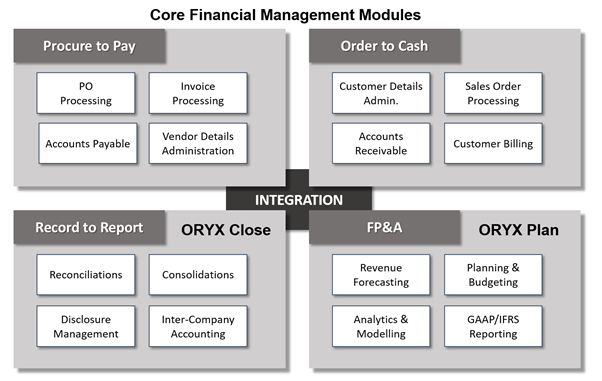Finance departments face many challenges when it comes to financial planning and analysis of a business. As the finance department is responsible to keep a close eye on the past, present and future of the financial health of the company, its critical to address the challenges faced by the finance team and help them have a systematic process to ensure business growth.
Businesses who implement financial analysis solutions to enable their finance functions to assess corporate performance through indicators (KPIs) such as revenue, return on investment (ROI), operational costs, and market and shareholder performance, are the ones equipped to gain competitive advantage.
By implementing financial analysis solutions, the results achieved can include vast time savings by streamlining processes and releasing staff for other activities, increased accuracy and reliability on reported numbers, and ultimately greater reporting for better decision making.
To get started however, finance departments are often faced with a number of challenges when assessing their KPIs:
- It is difficult to get hold of all the required inputs on time
- Input data is rarely error free and often needs cleansing and sorting-out before it can be used
- Data processing is done with complex spreadsheets which are difficult to maintain
- The volumes of input data get larger and more difficult to manage as the organisation grows
- The production of the outputs is time consuming and labour intensive
- Key stakeholders want the outputs faster (and sometimes more frequently) than they can be produced
ORYX Solutions to overcome Department Challenges
ORYX solutions are designed to support finance functions by addressing many of these challenges through the use of automation and data processing workflows. ORYX is completely configurable so it can take many forms of input, process the data as required and produce any sort of output.
The most typical ORYX solutions are for planning, budgeting, forecasting, or period end close activities, particularly for situations where either the finance system has insufficient analytical capability, the organisation is too complex to process data via spreadsheets, or the data processing and workflow needs to be tightly controlled and managed.
To facilitate this, Accountagility have created two ready-to-go solutions which can be used whole or in-part, which can take standard GL extracts from the core finance systems – these are:
- ORYX Plan – Financial Planning and Forecasting
- ORYX Close – Period End Closing

How does Automated Financial Solution work?
ORYX solution is a tool set. So you can start small and solve just one or two challenges like consolidations or reconciliations with appropriate adjustments being posted back to the General Ledger. Then, over time, you can slowly grow and expand your financial analysis solution to solve more of the challenges when resources and budget are available. Each new development builds on the existing workflows and data processing.
Once an ORYX solution has been established, all of the basic set up (e.g. dimensions, drivers, validations and data mappings) can be reused with any further modules. This ensures that the initial effort expended in setting-up ORYX solution can be capitalised upon to address different challenges later.
Common inputs and outputs of Financial Analysis Solution
A typical financial analysis solution involves the collection of data from one or multiple operational systems (e.g. Trial Balance, HR data, Sales data). The combination of this data is represented in a data model illustrating the dimensions of the business (e.g. Accounts, Products, Periods, Locations, Currency); and then looks at the performance of computations to produce reports or other outputs.
Common reporting outputs are financial statements such as Balance Sheets, Cash Flow or Income Statements. Many organisations also produce dashboards and calculate outputs such as adjustments or allocations which ORYX can post into the General Ledger.
ORYX solutions are equipped with many useful tools and features such as drill-to-source, customisable reports, dimensional analysis, charts, dashboards and data browsers; all of which make it easy to analyse data and create outputs.
Benefits of Financial Software
Financial planning and analysis software solutions help users to improve and streamline processes, and get data processing and workflow under tight control. Whilst the benefits are unique to each organisation, they are typically as follows:
- Control and Repeatability – the capturing of business logic and finance policies in one place introduces consistency into processes and reporting, and this becomes a valuable documentation asset for the department.
- Time Saving – reduced manual effort releases staff for other activities. Also, data, results and reports are available quicker for business decision making.
- Reliability – replacement of spreadsheets as the primary finance reporting tool removes the risk of hidden errors and key person dependencies.
- Accuracy – drill down capability enables finance to conduct robust variance analysis and provide confident explanations of performance figures.
- Handling of Foreign Currencies – the ability to hold all Forex policies at a system level saves time, reduces errors and enables underlying transactions to stay in their original currency removing confusion.
- Morale – the removal of menial and repetitive tasks from team members through automation improves job satisfaction as well as reducing errors.
To learn more, or request a free demonstration, click here

